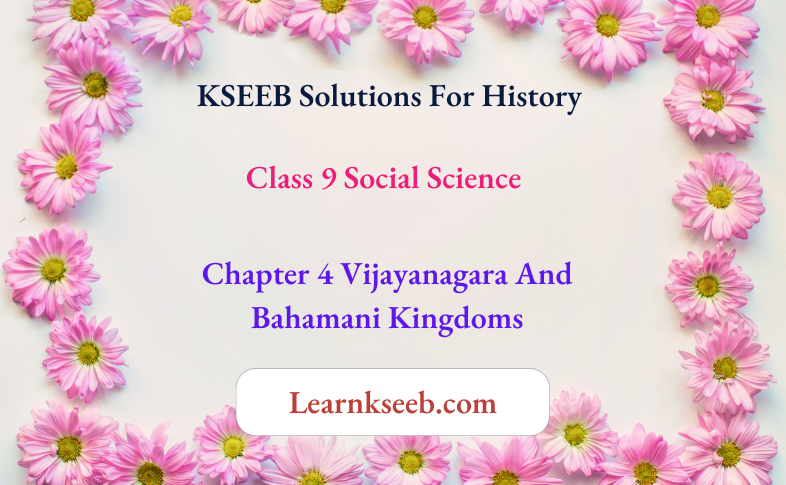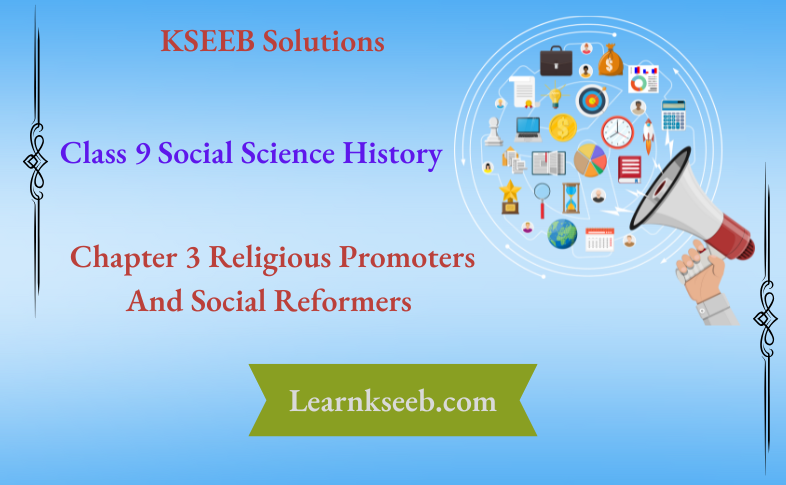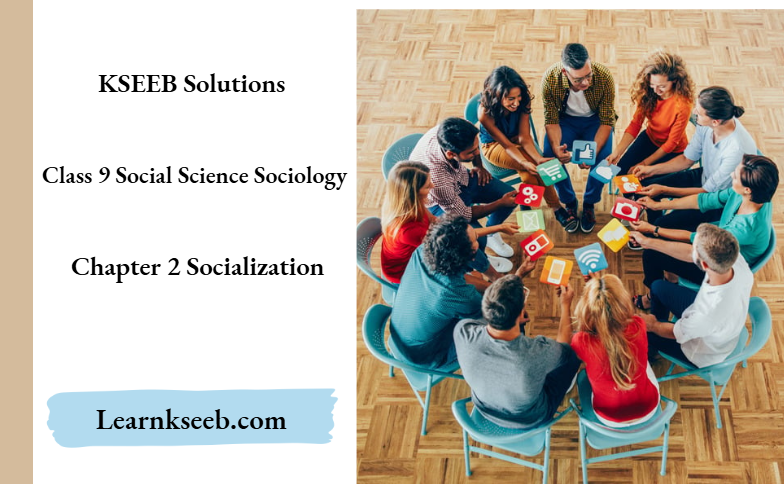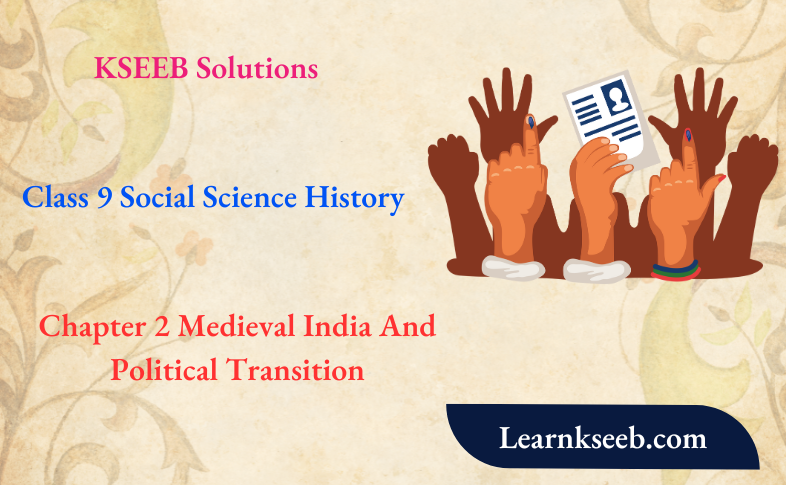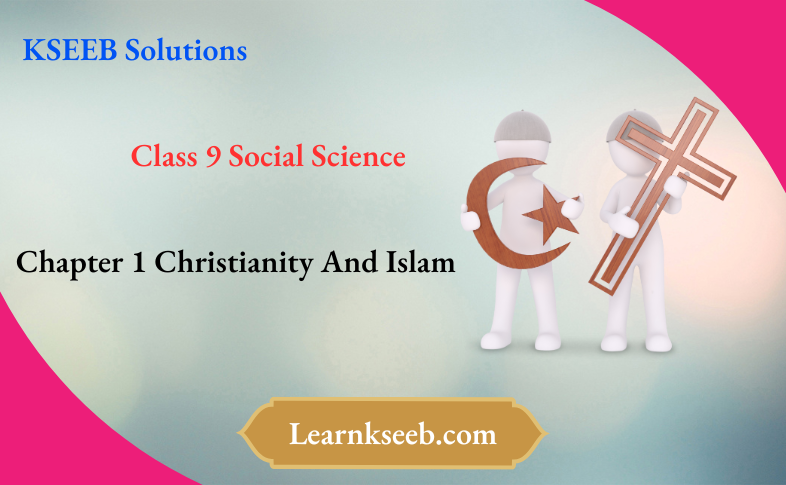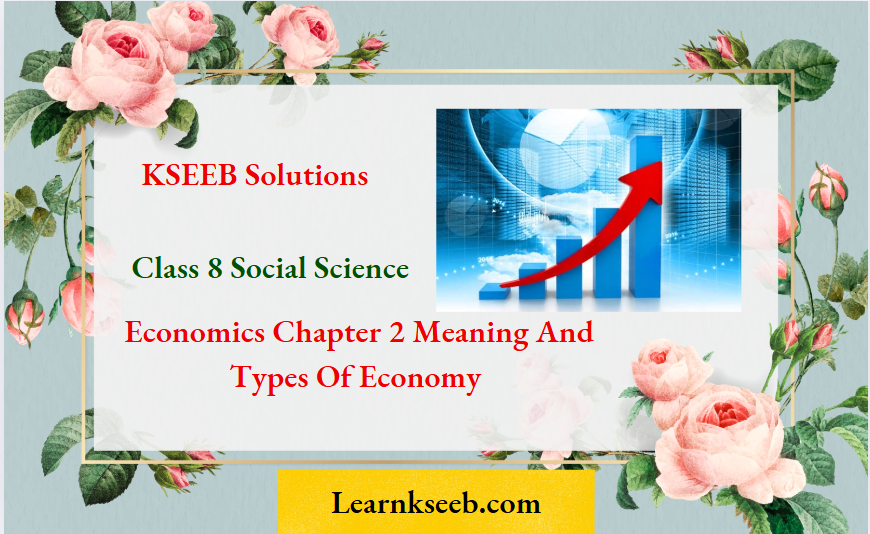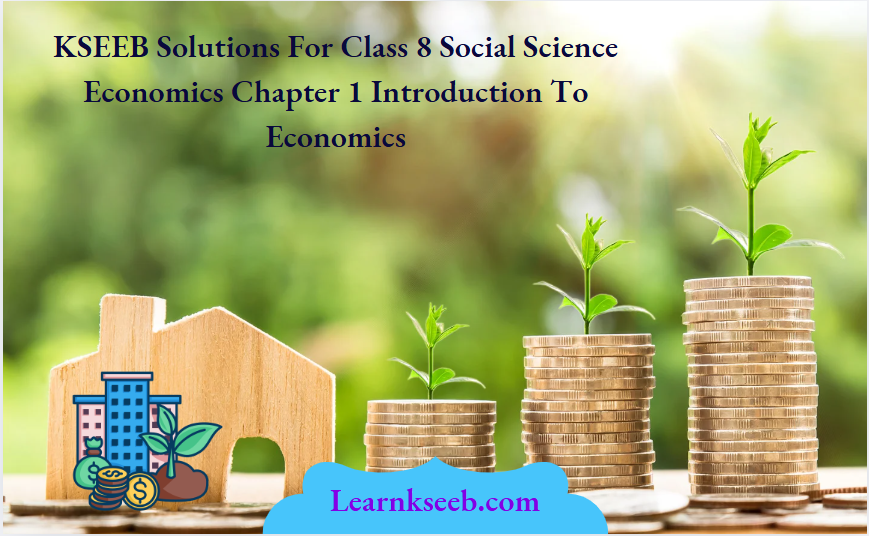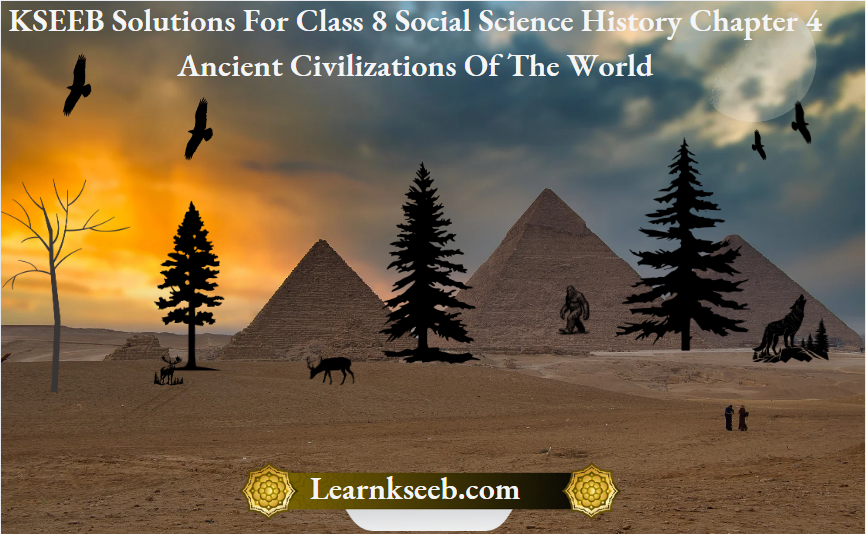KSEEB Solutions For Class 9 Science Chapter 9 Force And Laws Of Motion Important Concepts
Force: It is a push or pull acting on a body and its S.I un it is kgms’2 or newton
Newton: It is a force that produces an acceleration of 1 ms-2on a body of mass one kg.
Balanced forces: Two or more forces whose resultant is zero
Unbalanced forces: Two or more forces whose resultant is not zero
Newton’s first law of motion: Abody in the state of rest or motion will remain so unless acted upon by an unbalanced force.
Inertia: The natural tendency of a body to change its state of rest or uniform motion by itself Mass: It is a measure of inertia of a body and its S.I unit
Types of inertia: Inertia rest, the inertia of motion, and inertia of direction
Momentum: It is the amount of motion possessed by a moving body. It is measured as the product of the mass and velocity of the body. S.I unit is kgms-1
Newton’s second law: The rate of change of momentum of a body is directly proportional to the force and takes place in the direction of the force.
Newton’s third law of motion: For every action, there is an equal and opposite reaction.
Law of conservation of momentum: It states that the total momentum of a system of objects remains constant in the absence of any external force.
Friction: When a body slides or rolls on the surface of another body, then the force which opposes the motion of the body is called friction
Read and Learn More KSEEB Solutions for Class 9 Science
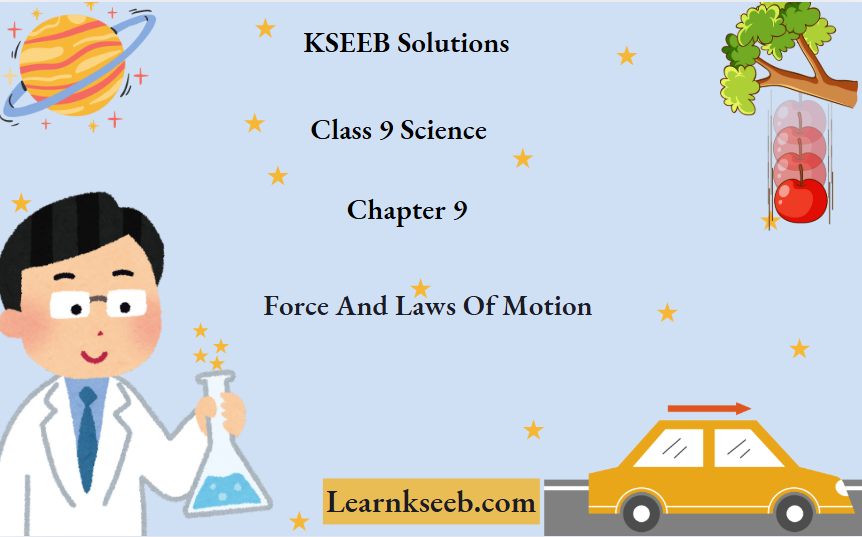
Force And Laws Of Motion Exercises
Question 1. Which of the following has more inertia?
1) a rubber ball and a stone of same size
2)a bicycle and a train
3) a five – rupees coin and a one-rupee coin?
Answer:
1) stone
2) train
3) a five rupees coin
Question 2. In the following example, try to identify the number of times the velocity of the ball changes: A football player kicks a football to another player of his team who kicks the football toward the goal. The goalkeeper of the opposite team collects the football and kicks it towards a player of his own team”. Also, identify the agent supplying the force in each case.
Answer:
The velocity of the ball changes 3 times. In the 1st case, a football player of one team supplies the force In the 2nd case, another player of the same team supplies the force In the 3rd case, the goalkeeper of the opposite team supplies the force
Question 3. An object experiences a net zero external unbalanced force. Is it possible for the object to be traveling with a non-zero velocity? If yes, state the conditions that must be placed on the magnitude and direction of the velocity. If no, provide a reason.
Answer: It is possible for an object to have a non-zero velocity when the ne force is zero. For example, when raindrops fall with a constant velocity, their weight is balanced by the viscous force of the air. Thus the net force will be zero. The magnitude and directions remain unchanged.
Question 4. A batsman hits a cricket ball which then rolls on level ground. After covering a short distance, the ball comes to rest. The ball slows to a stop because
(1) the batsman did not hit the ball hard enough.
(2) velocity is proportional to the force exerted on the ball.
(3) there is a force on the ball opposing the motion.
(4) there is no unbalanced force on the ball, so the ball would want to come to rest.
Answer: (3) there is a force on the ball opposing the motion.
Force And Laws Of Motion KSEEB Class 9 Question Answers
Question 5. A truck starts from rest and rolls down a hill with constant acceleration. It travels a distance of 400m in the 20s. Find its acceleration and force acting on it if its mass is 7 tonnes (1 tonne = 1000kg)
Answer:
Given, initial velocity (u) = 0, distance travelled (s) = 400m and t = 20s
Using the equation s = ut + 1/2 at2,
we get 400 = 0 +1/2 a(20)2=> a= 2 x 400 /400
= 2ms-2
Force (F) acting the truck= ma = 7000 x 2
– 14, 000N
Question 6. A stone 1 kg is thrown with a velocity of 20m/s across the frozen surface of a lake and comes to rest after traveling a distance of 50m. What is the force of friction between the stone and the ice?
Answer:
Given data,
Mass (m) = 1kg, initial velocity (u) = 20m/s, final
velocity(v) = 0 and distance travelled (s) = 50m
Using the equation v2 – u2 = 2as, we get
0 – (20)2 – 2a x 50 which gives a = – 400 /100
= – 4 m/s2
The negative sign indicates the retardation of motion of the body . The force of friction between the stone and ice
(F) = ma
= 1 x (- 4) = – 4N
Question 7. An 8000 kg engine pulls a train of 5 wagons, each of 2000kg along a horizontal track. If the engine exerts a force of 40000 N and the track offers a friction of5000N, then calculate
(1) the net accelerating force
(2) the acceleration of the train and
(3) the force of wagon 1 on wagon 2
Answer:
(1) The net accelerating force = Engine force – frictional force
= 40000 – 5000 = 35000N
(2) The acceleration of the train = a = F/m [ Since F = ma]
m = mass of the train = 8000 + 5 x 2000 =18000
Hence a = 35000/18000 = 1.94 m/s2
(3) The force wagon 1 on wagon 2 = The net accelerating force – a mass of
wagon 1 x acceleration of the train = 35000-2000 x 1.94 = 31.111 N
Question 8. An automobile vehicle has a mass of 1500kg. What must be the force between the vehicle and the road if the vehicle is stopped with a negative acceleration of 1.7 m/s2?
Answer:
Given, mass (m) = 1500 kg,
acceleration (a) = 1.7m/s2
The force required to stop the vehicle =ma
= 1500 x – 1.7 — – 2550N
Question 9. What is the momentum of the object of mass m, moving with a velocity v?
(1)(mv)2
(2)Mv2
(3) 1/2 mr
(4) mv
Answer: (4) mv
Question 10. Using a horizontal force of 200, we intend to move a wooden cabinet across a floor at a constant velocity. What is the friction force that will be exerted on the cabinet?
Answer: For the constant velocity, the net force on the wooden cabinet must be zero. This means that the friction force must be equal to the applied force ie 200N.
Question 11. Two objects, each of mass 1.5kg are moving in the same straight line but in opposite directions. The velocity of each object is 2.5m/s before collision during which they stick together. What will be the velocity of the combined object after collision?
Answer:
Given,
m1= m2 = 1.5kg and u1=2.5m/s , u2 =- 2.5m/s
According to the law of conservation of momentum
Total momenta after collision = Total momentum before the collision
\(\left(m_1+m_2\right) v=m_1 u_1+m_2 u_2\)
(1.5 + 1.5) v = 1.5 2.5 + 1.5 x (- 2.5)
3v = 3.75 -3.75 = 0
v=0
Class 9 Science Chapter 9 KSEEB Textbook Solutions
Question 12. According to the 3rd law of motion, when we push on an object, the object pushes back on us with an equal and opposite force. If the an object is a massive truck parked along the roadside, it will probably not move. A student justifies this by answering that the two opposite and equal forces cancel each other. Comment on this logic and explain why the truck does not move.
Answer: The student’s justification is wrong because action and reaction act on two different bodies and cannot cancel each other. The exact reason is that the frictional force between the tires and the road is greater than the push on it.
Question 13. A hockey ball of mass 200g traveling at 10m/s is struck by a hockey stick so as to return it along the original path with a velocity of 5m/s. Calculate the change of momentum that occurred in the motion of the hockey ball by the force applied by the hockey stick
Answer:
Given data,
Mass(m) = 200g = 0.2kg, Initial velocity (u) = 10m/s and final velocity (v) – 5m/s.
According to Newton’s 2nd law of motion, Change in the momentum of the hockey ball = m( v – u)
= 0.2 (- 5 – 10)
= – 3 kgm/s
Question 14. A bullet of the mass 10g traveling horizontally with a velocity of 150m/s strikes a stationary wooden block and comes to rest in 0.03 seconds. Calculate the distance of penetration of the bullet into the block. Also, calculate the magnitude of the force exerted by the wooden block on the bullet.
Answer:
Given data, mass (m) = 10g = 0.01kg, initial velocity (u) = 1 Om/s
Final velocity (v ) = 0 and time (t) = 0.03 s.
Using the equation, v = u + at, we get
a = (v – u)/t – (0 – 10)/0.03 = – 500Om/s2 (retardation)
Distance of penetration (s) = ut + 1/2 at2= 10
(0.03) + l/2 (-5000) (0.03)2 = 2.25 m
The magnitude of the force (F) = ma
= 0.01 x (5000) = 500N
Question 15. An object of mass 1 kg traveling in a straight line with a velocity of 10m/s collides with and sticks to a stationary wooden block of mass 5kg. Then they both off together in the same direction. Calculate the total mo men turning just before and after the impact. Also, calculate the velocity of the combined object
Answer:
Let m1 = 1 kg, m2= 5kg, U1= 10 m/s and u2 = 0
Total momentum just before the impact = m1 u1+m2 u2
= 1(10) + 5 (0) = 10kgm/s
According to the law of conservation of momentum, total momentum just after the impact = total momentum just before the impact = 10kgm/s
Hence(m1 + m2 )v = 10 where v = velocity of the combined object.
ie (1 + 5) v = 10 => v= 10/6 = 5/3 = 1.67 m/s
Question 16. An object of mass 100kg is accelerated uniformly from a velocity of 5m/s to 8m/s in 6 1 . Calculate the initial and final momentum of the object. Also, find the magnitude of the force exerted on the object
Answer:
Let m= 100kg, u = 5m/s and v = 8m/s
Initial momentum=mu = 100 (5) = 500 kgm/s
Final momentum=mv= 100 (8) = 800 kgm/s
According to Newton’s 2nd law of motion, F =Change in momentum/time
= (800-500) /6 = 50N
Question 17. For a statement refer textbook.
Answer: Raghul was correct ie both the motor car and the insect experience the same force and the same change in momentum. But the impact is greater on the
insect due to its small mass. Hence the insect died.
Question 18. How much momentum will a dumbbell of mass 10kg transfer to the floor it falls from a height of 80cm? (Take downward acceleration = 10m/s2)
Answer:
Given u = 0, s = 80cm = 0.8m and a = 10m/s2
We have v2 – u2 = 2as => v2-0 = 2 x 10 x 0.8
= 16 => v2= 16 ie v – 4m/s.
Hence momentum = mv = 10 x 4 40kgm/s
Force And Laws Of Motion Additional Questions
One Mark Questions
Question 1. Name the force which is responsible for a change in the position or state of an object.
Answer: Unbalanced forces
Question 2. How is inertia related to mass?
Answer: Inertia is directly proportional to the mass
Question 3. When we shake a fruit tree, fruits fall from the tree. Name the property
Answer: Inertia of rest
Question 4. Three balls made up of aluminum, steel and wood have the same volume and shape. Which of these has the highest inertia? Why?
Answer: Steel ball has the highest inertia because it has a maximum mass
KSEEB Solutions For Force and Laws Of Motion Short Notes
Question 5. Name the forces acting on a book kept on the table.
Answer: Gravitational force and frictional force
Question 6. How is inertia related to mass?
Answer: Larger the mass, the greater will be the inertia of the body.
Question 7. Mention S.I. unit of momentum kilogram -meter per second (kg ms1)
Answer: Kilogram – Metre per second (kg ms-1)
Question 8. Define the recoil velocity of a sun.
Answer: The velocity with which the gun moves back-ward when a bullet is fired horn it is forward direction is called the recoil velocity of the sun.
Question 9. Name the scientist who proved that objects need no net force for uniform motion.
Answer: Galileo
Question 10. What is the product mass of a body and its velocity called?
Answer: Momentum of the body.
Question 11. Name the physical quantity whose S.I. unit is lOg ms1
Answer: The momentum of a body
Question 12. How is force related to acceleration?
Answer: Acceleration is proportional to the magnitude of the force.
Question 13. Name the physical quantity which correct seconds to a rate of change of momentum.
Answer: Force
Question 14. On what principle a rocket work?
Answer: Law of conservation of momentum.
Question 15. Name the physical quantity which is a measure of inertia
Answer: Mass
Question 16. Name the scientist who gave the famous three laws of motion
Answer: Newton
Question 17. Name the forces acting on a book kept on the table.
Answer: Gravitational force and frictional force
Question 18. How is inertia related to mass?
Answer: Larger the mass, the greater will be the inertia of the body.
Question 19. Mention S.I. unit of momentum kilogram – meter per second (kg ms1)
Answer: Kilogram – Metre per second (kg ms-1)
Question 20. Define the recoil velocity of a sun.
Answer: The velocity with which the gun moves back-ward when a bullet is fired from it is forward direction is called the recoil velocity of the gun.
Question 21. State Newtont’s first law of motion
Answer: A body at rest or in uniform motion will remain so unless an unbalanced force acts on it
Question 22. Name the force which keeps a body moving in a circular path with constant acceleration
Answer: Centripetal force
Question 23. Define the momentum of a body
Answer: The amount of motion possessed by a body during its motion is called the momentum of the body
Question 24. How is force related to an acceleration of a body?
Answer: Force is directly proportional to acceleration
Question 25. Name the quantity measured by he product of mass and velocity
Answer: Momentum=mv
Question 26. On what principle a rocket work?
Answer: The law of conservation of momentum
Question 27. Name the quantity which corresponds to rate of change of momentum.
Answer: Force
Question 28. State Newton’s third law of motion
Answer: To every action, there is an equal and opposite reaction
Question 29. State the law of conservation of momentum
Answer: The total momentum of a system of objects in the absence of any external force remains constant.
Force and Laws Of Motion Class 9 KSEEB MCQ Solutions
Question 30. Define friction
Answer: When a body slides over the surface of another force, a force comes to act against the motion. This force is called friction
Question 31. Name the S.I units of
1) force
2)momentum
Answer:
1)S. I unit of force is newton
2)S. I unit of momentum is kgm/s
Question 32. Name the force which slows down a moving vehicle when we apply break.
Answer: Frictional force
Question 33. Name any two effects of a force on a body
Answer:
1) change in speed
2) change in direction of motion
3) change of shape
Question 34. What happens when a force is applied to a rigid body?
Answer: The body undergoes changes in shape and size
Question 35. A ball of mass 20g is moving with a velocity of 40m/s. What is its momentum?
Answer: Momentum = mv = 0.02kg x 40 m/s = 8 kg m/s
Question 36. What force is required to produce an acceleration of 5m/s2 in a body of mass 10kg?
Answer: F = ma = 10 5 = 50N
Question 37. A force of 10 N is acting on a body of mass 2kg. Calculate acceleration produced in the body
Answer: Acceleration (a) = F/m =10/2 = 5 m/s2
Question 38. Which would require greater force – accelerating 1kg mass at 10m/s2 or a kg mass at 4m/s2
Answer: F1 = 1 x 10 = 10N and F2 = 2 x 4 = 8 N
Question 39. Name the property of which a body resists a change in its state of motion. Name the physical quantity which is a measure of this property
Answer: Inertia and mass
Question 40. A man stands on frictionless ice in the middle of the pond. If he wants to reach the shore, what should be done?
Answer: He has waved his hands in the direction opposite to the shore
Question 41. What is the momentum of a toy car of mass 500g moving with a velocity of 2 ms-1
Answer: P mv = 500g x 2 ms-1
= 1/2 kg x 2 ms 1 = 1 kg ms-1
Question 42. Define the term force
Answer: A force is defined as a pull or push which tends to change the state of rest or uniform motion or direction of the motion.
Two Marks Questions
Question 43. Define resultant force
Answer: A single force that produces the same effect as that of a number of forces acting on a body is called the resultant force change in its state of rest or uniform motion in a straight line is called inertia of the body.
Question 44. State Newton’s second law of motion
Answer: The rate of change of momentum of a body is directly proportional to the force and the change takes place in the direction of the force
Question 45. Define inertia of rest. Give an example
Answer: The natural tendency of a body to remain in its state of rest is called inertia of rest. Example: When we shake the we clothes, water drops come out of the cloth due to the inertia of rest
Question 46. A bullet of mass 20 was horizontally fired with a velocity of 150ms-1 from a pistol of mass 2kg. What is the recoil velocity of the pistol?
Answer:
Net momentum before firing =Net momentum after firing
(2 + 0.02) x 0 = (0.02 x 150) + 2 x v 0 = 3+ 2v => 2v = – 3
v= -3/2 = -1.5ms-1
Negative sign indicates the gun moves in the di¬rection of motion of bullet.
Question 47. A car and a truck have the same momentum. Whose velocity is more and why?
Answer:
The velocity of the car is more.
Given P1 = p2
Mc Vc = Me Ve
Where Mc = Mass of car
Vc = Velocity of car
\( \mathrm{M}_{\mathrm{t}}\) = Mass of truck
Ve = Velocity of truck
Now \(\frac{M_E}{M_C}=\frac{V_c}{V_E}\)
[/latex]M_E>M_C \Rightarrow \frac{M_E}{M_C}>1[/latex]
Question 48. Mention one advantage and disadvantage of friction.
Answer: Friction plays an important role in breaking the system of vehicles. The wearing and tearing of tires is due to friction between tires and the road.
Question 49. Define inertia of motion. Give an example
Answer: The natural tendency of a body to remain in its state of uniform motion in a straight line is called inertia of motion
Example: When a bus driver applies brakes suddenly to stop a moving bus, the passengers in the bus move forward due to inertia of motion.
Question 50. Define inertia of direction. Give an example
Answer: The inability of a body to the change of direction of the motion itself is called inertia of direction Example: When a knife is sharpened by a grinding stone, the streaks of fire appear tangential to the stone. This is due to the inertia of direction.
Example: When a car suddenly turns around a circular path, the passengers in the car are thrown outwards due to inertia of direction.
Question 51. What are the changes possible on an object at rest when
(1) a balanced force
(2) an unbalanced force act on It?
Answer:
1) The balanced force changes the shape and size of the object
2) The unbalanced force changes the state of rest or uniform motion of the body.
KSEEB Class 9 Science Chapter 9 Important Questions
Question 52. Differentiate between balanced and unbalanced forces
Answer:
Balanced forces: The forces whose resultant is zero are called balanced forces. They may change the shape of the body.
Unbalanced forces: The forces whose resultant is not zero. They change the state of rest or uniform motion of a body.
Question 53. What happens if a fielder stops the fast-moving ball suddenly? Justify your answer.
Answer: The fielder gets his hand hurt by stopping the ball suddenly. Due to the short time of impact, the rate of decrease of momentum of the ball is large and it exerts a large force on the hands of the fielder which may hurt his hands.
Question 54. The following is the distance-time table of an object in motion :
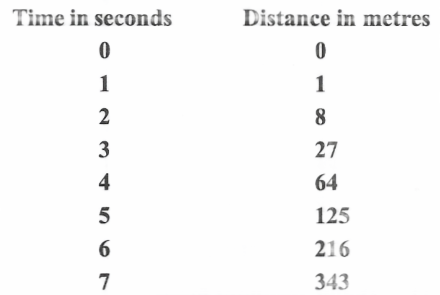
(1) What conclusion can you draw about acceleration? is it constant, increasing, decreasing, or zero?
(2) What do you infer about the forces acting on the object?
Answer: Using the formula \(\mathrm{V}=\frac{s_2-s_1}{t_2-t_1}\)
and \(a=\frac{v_2-v_1}{t_2-t_1}\)
we get a = 1 m/s2, a2 = 6 m/s2 ,a3 = 12 m/s2 ,a4 = 18 m/ s2, a5= 24 m/ s2, a6 = 30 m/s2 and a7 = 36 m/s2. These values indicate
(1) acceleration increases un informally
(2) Since F x acceleration, the force also increases uniformly.
Question 55. Two persons manage to push a motorcar of mass 1200 kg at a uniform velocity along a level road. The same motorcar can be pushed by three persons to produce an acceleration of 0.2 ms-2. With what force does each person push the motorcar? (Assume that all persons push the motorcar with the same muscular effort).
Answer: The force applied by 3rd person=ma = 1200 x = 0.2 = 240N
Since all three persons use the same muscular effort, each person exerts a force 250 N.
Question 56.A hammer of mass 500g. moving at 50 ms1, strikes a nail. The nail stops the hammer in a very short time of 0.01 s. What is the force of the nail on the hammer?
Answer: For the hammer, mass(m) = 500g = 0.5kg, u = 50m/s, t = 0.01s and v – 0 The force of hammer on the nail = ma = m(v-u)/t ;
= 0.5 (0 – 50) / 0.01 = – 2500N Since the nail stops the hammer, the force of nail on the hammer =- F = 2500N •
Three Marks Questions
Question 57.
1) State Newton’s third law of motion
2) Express Newton’s second law mathematically explaining the symbols used
3) Define the SI unit of force from this expression
Answer:
1) The rate of change of momentum of a body is directly proportional to the force and the change takes place in the direction of the force
2) Mathematical expression for the force is F = ma where m = mass and a = acceleration of the body
3) When m = 1 kg and a = 1 m/s2 , then F = 1 newton. Thus one newton is the force that produces unit acceleration in the unit mass.
Question 58. State and explain Newton’s third law of motion
Answer:
Statement: To every action, there is an equal and opposite reaction
Explanation:

Let us consider two spring balances connected together as shown in the above fig. The fixed end of balance B is attached with a rigid support, like a wall. When a force is applied through the free end of spring balance A. it is observed that both the spring balances show the same readings on their scales. It means that the force exerted by spring balance A on balance B is equal but opposite in direction to the force exerted by the balance B on balance A, The force that balance A exerts on balance B is called the action and the force of balance B on balance A is called the reaction. This gives us an alternative statement of the third law of motion i.e., to every action there is an equal and opposite reaction. However, it must be remembered that the action and reaction always act on two different objects.
Question 59. Explain the working of a rocket based on the law of conservation of momentum
Answer: When a rocket is fired, a large of hot gases due to the combustion of fuel is thrown out vertically downward with a large velocity and hence a large momentum toward the ground. According to the law of conservation of momentum, the rocket gets an equal and opposite momentum due to which it moves vertically upwards.
Question 60. Give an example
1) How force can change the velocity of a body
2) balanced forces
Answer:
1) When we apply brakes to a moving car, the car slows down
2) In a tug of war, the rope does not move in any direction due to equal and opposite forces (balanced forces) applied by the two teams
Question 61. Give reason:
1) When we step on the peel of a banana, we slip
2) Athletes in a high jump event made to fall either on a cushioned bed or on a sand bed
3) The tires of the vehicle wear out
Answer:
1) The smooth surface of the peel reduces the friction between the feet and the peel. Hence we slip
2) When the athlete falls on a cushioned bed or a sand bed, the time interval for which the force acts increases, and the rate of change of momentum and hence the force of reaction decreases. Thus the athlete does not hurt.
Newton’s Laws Of Motion Explained Class 9 KSEEB Solutions
Question 62. Give reason:
1) Shock absorbers are used in cars and motorcycles
2) glass or chinaware is packed with straw
3) road accidents at high speeds cause more damage than accidents at low speeds
Answer:
1) The shock absorbers increase the time interval of the jerk which in turn decreases the rate of change of momentum and reaction of the force on the passengers
2) The straw reduces the time interval of jerk during transportation. this reduces the effect of the force between chinawares and avoids damage.
3) At high speeds, the time of impact of vehicles is very short. So they exert very large forces on each other. Hence damage is more.
Question 63. Give reason:
1) When a gun is fired, the gun recoils
2) As the sailor jumps in the forward direction, the boat moves backward
3) We can’t walk with legs perpendicular to the ground
Answer:
1) When the gun is fired, it exerts a forward force on the bullet. In turn, the bullets exert an equal and opposite force (Newton’s 3,d law) on the gun. Hence the gun recoils
2) As the sailor jumps in a forward direction(action), he exerts equal and opposite force on the boat. Hence the boat moves backward.
3) We our legs are perpendicular to the ground, the .ground exerts an equal and vertically opposite force on the legs. Hence we feel motionless.
Question 64. Give reason:
1) It is easier to stop a tennis ball than a cricket ball moving with the same speed
2) All cars are provided with seat belts
3) Water sprinkler used for grass lawns begins to rotate as soon as the water is supplied
Answer:
1) The mass of a tennis ball is smaller and hence it has smaller momentum and a smaller force is required to stop it.
2) Seat belt increases the time interval of forward motion during the accident. This reduces the reactionary force on the passenger and prevents serious injury
3) The rushing water out of the sprinkler exerts a reactionary force on the sprinkler.
Question 65. From the air-filled balloon, the air is released from its mouth in a downward direction. Write the other observations made by you and justify your answer.
Answer: The balloon moves vertically upward direction due to Newton’s 3rd law of motion.
Question 66.
1) Define momentum.
2) A ball weighing 500g is thrown vertically upward with a speed of lOm/s. What will be its momentum
- initially
- at the highest point?
Answer:
1) Refer ans of Q. 11
Given mass(m) = 500g = 0.5kg andu= 10m/s
Initial momentum = mu = 0.5 x 10 = 5N
The highest point, v = 0. Hence momentum
= 0.5 x 0 = 0
Four Marks Questions
Question 67.
1) State the law of conservation of momentum.
2) A body of mass 2 kg initially moving with a velocity of lOm/s, collide with another body of mass 5kg at rest. After a collision, the velocity of the first body becomes Im/s. Find the velocity of the second body.
Answer:
1) refer ans of Q. 18
2) Before collision: m1= 2kg, m2 = 5kg, u1 = 10m/s and u2 = 0
After a collision, v1 = 1m/s, and v2 =?
According to the law of conservation of momentum,
Final momentum= Initial momentum
\(\mathrm{m}_1 \mathrm{v}_1+\mathrm{m}_2 \mathrm{v}_2=\mathrm{m}_1 \mathrm{u}_1+\mathrm{m}_2 \mathrm{u}_2\)
2(10) + 5(0) = 2(1) + 5(V2) => 5v2 + 2 = 20 =>
5v2 = 18
Hence v2 = 18/5 = 3.6m/s .
Question 68.
1) State Newton’s first law of motion.
2) Deduce Newton’s first from Newton’s second law of motion
3) What will be the acceleration of the car of mass 1200 kg on applying a force of 120N on it?
Answer:
1) Refer Ans of Q. 9
2) According to Newton’s 2nd law of motion, F = ma = m(v – u) /t where u = initial velocity, v = final velocity and m = mass of the body
If F = 0, then m(v – u) = 0 => v u = 0 (since m=O)
Thus we get v=u ie uniform motion
Thus a body is confined with uniform motion when the force on it is zero.
This is the statement of newton’s first law of motion
3) acceleration of the car = Force/mass = 120 /1200 = 1/10-0. lm/s2
KSEEB Chapter 9 Class 9 Detailed Solutions On Force
Question 69.
1) State Newton’s second law of motion.
2) Derive the expression for the force in terms of acceleration and mass of a body
3) A cricket player lowers his hands while catching a ball. Why?
Answer:
1) Refer ans of Q. 13
2) Consider an object of mass ‘m’ moving with an initial velocity ‘u’ along a straight line. It is accelerated uniformly to a velocity ‘v’ by applying a constant force ‘F’.
Initial momentum of the object ( p1 ) = mu
Final momentum of the object (p2) = mv
The change in momentum=p2– p1 = mv – mu
= m(v-u)
The rate of change of momentum
= m(v-u)/t
According to Newton’s second law of motion F cc m (v – u) /t = k ma
Question 70.
1) State the law of conservation of momentum
2) Prove the law of conservation of momentum by taking the case of two balls
3) A bullet of mass 20g is horizontally fired with a velocity of 150m/s from a pistol of mass 2kg. What is the recoil velocity of the pistol?
Answer:
1) Refer ans of Q. 18.
2) Consider two ball A and B of masses mA and mB are traveling in the same direction along a straight line at different velocities uA and (uA > uB) respectively.
Let the balls collide each other as shown in the figure. During the collision, ball A exerts a force FABon ball B and ball B exerts a force FDA on ball A.
Let vA and vB be the velocities of the two balls A and B respectively after the collision. If he t be the time of impact of the collision, then
The rate of change of momentum of ball A= \( m_A\left(v_A-u_A\right) / t\)
The rate of change of momentum of ball B =\(\left(v_B-u_B\right) / t\)
According to Newton’s 3rd law of motion
\(\mathrm{F}_{\mathrm{AB}}=-\mathrm{F}_{\mathrm{BA}} \Rightarrow \mathrm{m}_{\mathrm{A}}\left(\mathrm{v}_{\mathrm{A}}-\mathrm{u}_{\mathrm{A}}\right) / \mathrm{t}\)
\(=-\mathrm{m}_{\mathrm{B}}\left(\mathrm{v}_{\mathrm{B}}-\mathrm{u}_{\mathrm{B}}\right) / \mathrm{t}\)
This gives \( \mathrm{m}_{\mathrm{A}} \mathrm{u}_{\mathrm{A}}+\mathrm{m}_{\mathrm{B}} \mathrm{u}_{\mathrm{B}}=\mathrm{m}_{\mathrm{A}} \mathrm{v}_{\mathrm{A}}+\mathrm{m}_{\mathrm{B}} \mathrm{v}_{\mathrm{B}}\)
ie Total momentum of balls A and B before collision = Total momentum of the balls A and B after the collision . This proves the law of conservation of momentum
3) Total momentum of the pistol and bullet before firing = (2 + 0.02)kg x 0 m/s = 0
The total momentum of the pistol and bullet after the firing – (0.02 x 150) + ( 2 x v) where v – velocity of recoil of the gun
Total momentum after the firing =total momentum before firing 3+2v = 0 => v = – 3/2 = – 1.5m/s
Question 71. Explain Galileo’s experiment with marbles to prove that no net force is needed for uniform motion.
Answer:

When a marble rolls down an inclined plane, its velocity increase. But its velocity decrease gradu¬ally when it climbs up the opposite inclined plane. This is due to friction which opposes the mo¬tion. However when the inclined planes are fric¬tionless, the marble roll down the slope of left inclined plane and moves up the right and opposite inclined plane to the same height from it which it was released.
If the angle of inclination of the right side plane is gradually decreased, the marble travels more and more distances in order to reach its original height. If the right side plane is made completely horizontal, the marble would continue to move to reach the same height from which it was released. This means that no net force is required for uniform motion.
Question 72.
1) Define force. Mention S.I. unit of force
2) Mention any two possible effects of force
Answer:
1) Force is defined as a push or a pull that changes or tends to change the state of rest or uniform motion or direction of motion of a body.
S.I, unit force is Newton,
2) The possible effects of force are
- change the speed of the body
- change the direction of the motion
- change the shape and size of the body
Question 73.
1) State Newton’s three laws of motion
2) Define the inertia of a body
Answer:
First law: A body at rest or in uniform motion will remain so unless an unbalanced force acts on it.
Second law: The rate of change of momentum of body is directly proportional to the applied unbalanced force and the change takes place in the direction of the force.
Third law: Action and reaction are equal and opposite and they act on different bodies.
Inertia: The natural tendency of a body to oppose any change in its state of rest or uniform motion in a straight line is called the inertia of the body.
Force And Laws Of Motion KSEEB Class 9 Question Answers
Question 74. State Newton’s first law of motion. Explain it with the help of suitable examples.
Answer:
Newton’s first law: A body at rest or in uniform motion will remain so unless an unbalanced force acts on it.
Explanation: According to Newton’s first law, a body at rest continues to be rest. For example, a passage sitting in a bus moves backward, when the bus starts suddenly. When the bus moves forward, his foot which is in contact with the moves forward, while his upper body moves backward.
The law also states that a body in uniform motion continues to be in the straight path. This can be explained in the following example.
When a mining bus suddenly stops by applying brakes, a passenger standing in the bus moves forward. When the bus stops suddenly, the lower part of the body comes to rest while the upper part tends to move forward.
Thirdly the law states that a body with uniform motion along a straight path cannot change its di¬rection itself When a moving bus turns around a sharp bend, a passenger in the bus tends to move sidewise. His lower part moves in the direction of motion while his upper part tends to be in the original direction.
Question 75.
1) State and explain Newton’s second law of motion.
2) A cricket player lowers his hands while catching a fast-moving ball. Explain.
Answer:
Newton’s Second Law
1) The rate of change of momentum of an object is proportional to the applied unbalanced force in the direction of the force. When a larger force is applied on a body, the velocity of the changes, and hence momentum = mv also changes. This change in momentum is proportional to the force.
2) By lowering their hands, the fielder increases the time during which the high velocity of the moving ball decreases to zero. Thus acceleration of the ball is decreased and therefore the impact of catching the fast-moving ball is also reduced. If the ball is stopped suddenly, then its high veloc¬ity decrease to zero in a very short interval of time. Thus the rate of change of momentum of the ball will be very large. Therefore, a larger force would have to be applied for holding the catch that may hurt the palm of the fielder.
Question 76.
1) State and explain Newton’s second law of motion.
2) A force of 5N gives a mass m1. an acceleration of 10ms’2 and a mass m2, an acceleration of 20ms”2. What will be acceleration produced by the same force if both the masses were tied together?
Answer:
1) Refer the above answer
2) From Newton’s 2nd law of motion
\(m_1=F / a_1=5 / 10=0.5 \mathrm{~kg}\)
\(m_2=F / a_2=5 / 20=0.25 \mathrm{~kg}\)
Now combined mass = 6.5 + 0.25 = 0.75kg acceleration of combined
Mass (a) = \(\frac{F}{m_1+m_2}=\frac{5}{0.75}=6.67 \mathrm{~ms}^{-2}\)
Question 77. A constant force acts on an object of mass 5kg for a duration of 25. It increases the object’s velocity from 3ms-1 to 7ms-1. Find the magnitude of the applied force. Now, if the force was applied for a duration of 5S what would be the final velocity?
Answer:
Case (1): Given
Initial velocity (u) – 3ms-1
Final velocity (v) = 7 ms-1
mass (m) = 5kg
time (t) = 2s
According to Newton’s 2nd law of motion F = ma
F = m(v – u)/t
F = \( \frac{5(7-3)}{2}=\frac{5 \times 4^2}{\not 2}\)
F = 10N
case (2): When t — 5s than 10 = 5(v – 3)/5
50 = 5 (v – 3) => 10 = v- 3 => v= 10 + 3 => v = 13 ms-1
Question 78.
1) State and explain Newton’s third law of motion.
2) What do you mean by the recoil of seen action and reaction are equal and opposite and they act on different bodies?
Answer:
1)When one object exerts a force (action) on another object than the second object also exerts a force (reaction) on the first. These two forces are always equal in magnitude but opposite in direction. The third law indicates that a single force can never exist.
2) When a bullet is fired, the gun exerts a for-ward force on the bullet. In turn the bullet exerts an equal and opposite reaction force on the gun. As a result, the gun moves backward. This is known as the recoil of the gun.
Question 79. Two hockey players of opposite teams, while trying to hit a hockey ball on the ground collide and immediately become entangled. One has a mass of 60kg and was moving with a velocity 5ms’1 while other has a mass of 55kg was moving faster with a velocity 6ms1 toward the first player. In which direction and with what velocity will they move after they become entangled? Assume the frictional force acting on them is negligible.
Answer:
Let m1 = 60kg u1= 5 ms-1
m2 = 55kg u2 = -6ms-1
Before collision,
Net momentum= \(m_1 u_1+m_1 u_1\)
= 60 x 5 + 55 x (-6)
= 300 – 300 = -30 kg ms-1
After collision
Net momentum = ( m1 + m2 ) V = (60 + 55)V = 115 V
According to the law of conservation of momentum
Net momentum before the collision = Net momentum after the collision
– 30 = 115 V => V = (-30/115) = -0.26 ms-1
The entangled players move in the direction the second player was moving before the collision.
Force And Laws Of Motion Application Questions
Question 1. Name an art based on Newton’s third law of motion.
Answer: Karate
Question 2. Which law of motion is called the law of iner¬tia?
Answer: Newton’s first law of motion.
Question 3. Name the unbalanced force which slows down a moving bicycle when we stop pedaling it.
Answer: Friction
Question 4. A person walks West to East direction. What will be the direction of friction between his feet and road.
Answer: East to west
Question 5. We tend to fall when we step on the peel of a banana. Why?
Answer: Peel of bananas reduces the friction between our feet and the road. Due to unbalanced force, we tend to fall.
Question 6. Explain why some of the leaves may be detached from a tree if we vigorously shake its branch.
Answer: Initially, the leaves are at rest. When a branch is shaken vigorously, leaves are set into motion. This motion is opposed by the inertia of the rest of the leaves. Hence they get detached.
Question 7
1) Why do the passengers in a bus tend to fall forward when it suddenly stops?
2) Why do the passengers in a bus tend to fall back when it starts suddenly?
Answer:
1) When the bus comes to rest suddenly, the lower part of the body which in contact with the floor of the bus also comes to rest. At the same time, the upper part of the body has the tendency of moving due to the inertia of motion. Hence the passenger fells forward.
2) When a bus accelerates suddenly, the lower part of the body which is in contact with the floor of the bus is set into motion. At the same time, the upper part of the body has a tendency of rest due to the inertia of rest. Hence the passenger falls backward.
Question 8. When a carpet is beaten with a stick, dust comes out of it. Explain why?
Answer: Initially, the dust is at rest on the carpet. When the carpet is beaten with a stick, the dust is set into motion. But this motion is opposed by the inertia of the rest. As a result, the dust gets detached from the carpet.
Question 9. Why is it advised to tie any luggage kept on the roof of a bus with a rope?
Answer: When the bus starts suddenly or stops suddenly or takes a turn, the luggage may fall due to inertia of rest or motion or direction kg-m/s-1
